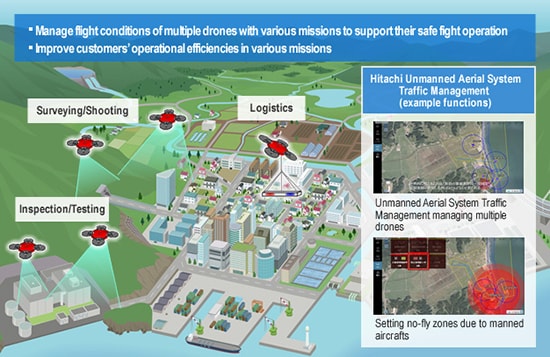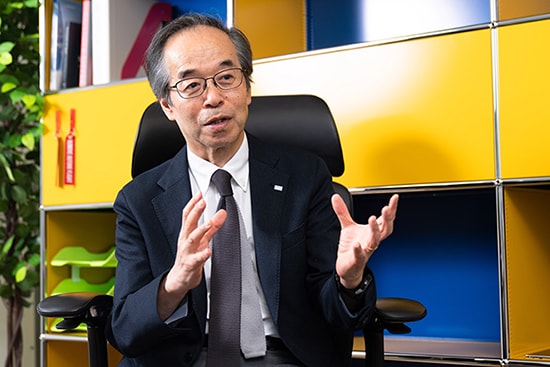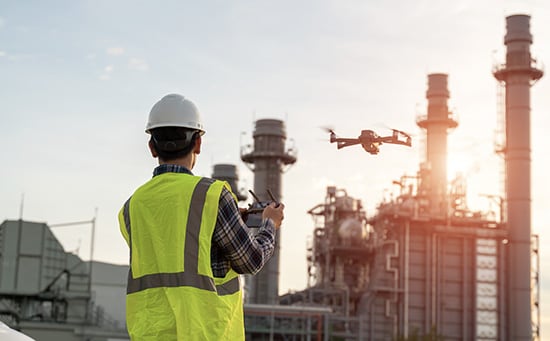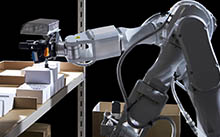Drones are significantly changing how we live. Through the full utilization of their major advantage of being able to fly through the skies, they are expected to contribute to the quality of life (QoL) of people in a wide range of situations, from deliveries and accessing hard-to-reach areas, along with inspections of tower facilities, all the way to the delivery of supplies in disaster situations, along with searches during such situations. One example of drone application can be found in the Republic of the Malawi by the United Nations Children's Fund (UNICEF). Backing Malawi's rebirth as a regional society where people can live in safety, security, and health, UNICEF is leading efforts to conduct the demonstration testing of drones in delivering medicines and collecting blood samples. For drones to further embed themselves into future society, however, advances in technology development and lawmaking by both national and international bodies will be necessary. To this end, Hitachi has fully committed itself to contributing to finding solutions to societal challenges that use drones through the tandem themes of technology development and lawmaking.

Several hurdles must be surmounted in order to create a future in which drones can fly freely in any direction through. Drones also need to fly faster and farther and must have a higher load capacity.
Of primary concern is safety. Crucial to safety will be high-precision operation control systems in the shape of an unmanned aircraft system traffic management (UTM) system. The current use of drones is predicated on having an operator or controller who visually tracks the drone. In order to obtain widespread use of drones, however, it is imperative to achieve flight beyond the visual line of human sight.
Flight beyond the visual line of sight is a considerable technical challenge. There is no need to worry about collisions when multiple drones are flying across a wide open sky, however in the case of urban areas crowded with pedestrians and buildings, a system that permits their flight in mutual safety is vital. The UTM makes this possible.
A UTM is analogous to an air traffic control system. It manages the positional and destination information of all drones in flight, and if drones are on merging courses, advises to change flight paths. In addition, when helicopters or other manned aircraft enter the airspace, the system provides notification of a danger area thus created. Furthermore, when drones are to be used by multiple businesses for different purposes, the system also has the role of consolidating the flight plans and status of each drone and delivering this information to each business.
However, for drones to be utilized in multiple services, technological development and the formation of laws that can be used across all industries also must be accelerated.

Professor Shinji Suzuki, specially-appointed professor at the University of Tokyo's Institute for Future Initiatives (Photograph: Daisuke Yoshinari)
Japan Unmanned System Traffic & Radio Management Consortium (JUTM), launched in July 2016 and headed by Representative Director Shinji Suzuki, a specially-appointed professor at the University of Tokyo's Institute for Future Initiatives, is actively engaged in considerations on laws and mechanisms for the societal implementation of UTM. JUTM activities are tasked with promoting the technological development and environment-building necessary for the safe operation of drones and other unmanned aircraft. In this respect, JUTM is actively conducting discussions and verifications aimed at the practicalization of UTM. According to Professor Suzuki: "Consortium members from various industries discuss issues such as what an ideal drone management and drone environment-building will be necessary, in this way taking part in the devising of national laws."
Currently, JUTM has a membership of over 400 participating organizations. Among these, Hitachi is one of the few members that has been involved since consortium establishment. Conducting its own original development of UTMs for drones, Hitachi has been supplying drone systems tailored to the individual applications of users from diverse industries. The implementation of drones, however, will require the alignment of all companies in building the infrastructure at a societal level. In this regard, Hitachi is utilizing its rich experience in working on advanced IT systems for the support of railways and large-scale networks and is using its extensive knowledge on international standardization in a number of technical fields to maintain its involvement in rulemaking while leading in consortium discussions.
According to Atsushi Yokoyama of the Hitachi Drone Business Development Center, "Promoting the revision of regulations and the making of new rules are central to the wide use of drones in solving societal issues. JUTM gathers member views and advocates as a representative of Japanese industry."
As expected, dynamic discussions on drone use are also taking place overseas. If Japan proceeds while neglecting these discussions, it runs the risk of falling behind in worldwide trends.
Taking this into consideration, JUTM is also focusing on international standardization activities. As an example of this, the ISO SC16 subcommittee for promoting the standardization of drones and other unmanned aircraft was established within the ISO, with the United States serving as the chair. Also, a UTM working group was started up within the ISO SC16 subcommittee at the request of JUTM. According to Kosuke Suda of the Government & Public Corporation Information Systems Division: "The request was put to ISO at the initiative of Hitachi and JUTM. The startup of the new UTM working group was approved, and the working group's international chair is Hitachi."
Along with lawmaking, demonstration testing is also crucial toward enabling the widespread use of drones. JUTM plays a part in this too, with consortium members collaborating in the conducting of different types of demonstration tests.
It is important for accelerating Japan‘s drone development in that even organizations with no affiliation with JUTM or other industry groups have access to a field for testing drone systems that are under development in order to identify problem areas. Such venue , called the "Fukushima Robot Test Field" (Fukushima RTF), has been established in an area stretching between Minami-soma City and Namie Town, Fukushima Prefecture. The Fukushima RTF originated out of the Fukushima Innovation Coast Scheme, which was put together for the purpose of industrial rehabilitation in the Fukushima Hama-dori area. The Fukushima RTF is a research & development base where the demonstration testing of drones and other robots can be carried out while replicating actual usage environments. An open facility available for anyone to freely use, it is expected to serve as a place for accelerating the development of Japan's robot industry. In the short term, it will offer a high degree of freedom, and developers, startups, universities, and research institutions are expected to use it. In the long-term, with the situating nearby of a robot industrial base, the aim is to become a base for quality control and performance checks. According to Mr.Akifumi Kitajima, head of the Fukushima Robot Industry Promotion Council: "We want to root the robot industry in this area by developing it as a center for the industry of next-generation robots, including drones. We also want to use the Fukushima RTF as a way to bring the industry and people together, such that the Fukushima RTF can play a central role in economic revitalization. At the same time, we seek to actively attract people in addition to enterprises by promoting human resources development and personnel exchange."
As the robot industry grows, drones, in particular, are squarely in the spotlight. For drones to be used in a variety of different use settings, an environment must be developed that lets drones on different missions fly safely at the same time. To accomplish this, drone manufacturers need an environment in which they can connect with a UTM to perform demonstration testing without having to go through a mass of complicated procedures. Fukushima RTF represents such an important place, and Hitachi supports it behind the scenes.


Fukushima Robot Test Field (Fukushima RTF) (Photograph provided by the Fukushima RTF)
With a view toward advancing the widespread use of drones, Hitachi is also promoting the development of technology that links drones with Lumada. This involves a system in which the data collected by the drone is analyzed by an IoT platform.
For example, bridge inspections are a case in which drone features are maximally utilized. With as many as 700,000 bridges in Japan, it is desirable to be able to inspect their deterioration with efficiency. Drone photography of bridge surface condition yields an inspection efficiency much higher than current manual methods. Hitachi is going forward with demonstration testing in which images and video captured by drones are linked to Lumada's artificial intelligence (AI), a configuration that efficiently accomplishes deterioration detection that until now has depended on the experience of expert inspectors. In this way, Hitachi is providing as a drone platform a one-stop service that includes both a UTM for managing drone operation and Lumada-linked data analysis.

A society that can implement UTM would be able to witness the realization of previously unconceived drone applications. The day may soon come when drones drop from the sky with deliveries, carry heavy packages for people, and otherwise help people out. This will lead not only to business value for service providers, but also to improved Quality of Life for people. To achieve such a society, Hitachi will continue to collaborate with business partners of various industries, contributing to the tandem themes of technology development and lawmaking and to staging opportunities in the pursuit of drone solutions.
Release Date: March 2020
Solutions By: Drone Business Development Center, Hitachi, Ltd.







